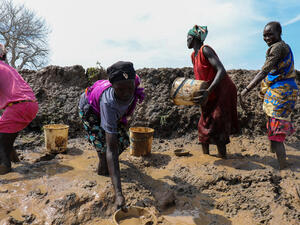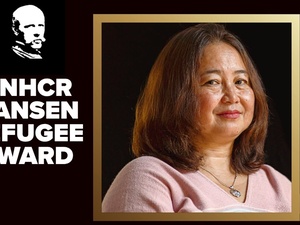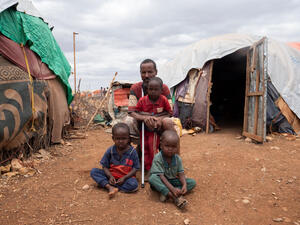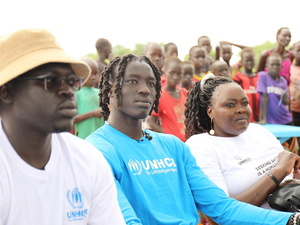Thousands displaced and trapped by fighting in northern Yemen
Thousands displaced and trapped by fighting in northern Yemen
We are increasingly concerned about the fate of thousands of Yemeni civilians caught in escalating fighting between Al Houthi rebels and the government forces in the mountains of northern Yemen. It is estimated the fighting around Sa'ada city displaced some 35,000 people in the past two weeks alone.
According to those fleeing from this remote, inaccessible part of Sa'ada governorate, the situation appears to be critical in Sa'ada city and further north in Addahar district, as well as in El Sufyan in neighbouring Amran governorate, The roads to Sa'ada governorate are blocked and there is no access to the conflict areas by air. Many attempting to flee are taking great risks and are paying smugglers to get out.
Since 2004, the clashes between the Al Houthi rebels and government troops in Sa'ada governorate have affected an estimated 120,000 people.
The Al-Talh camp, one of four camps for internally displaced people (IDPs) in Sa'ada city run by the Yemeni Red Crescent, continues to receive a steady influx of displaced families. Some 5,250 IDPs fled there early last week from the nearby Al Anad camp, which became a battleground over the past few days. Civilians are also fleeing north and west towards the Saudi border in Baqim and in Mandaba. Others are moving east, looking for shelter on the outskirts of Dhahian city and Sahar district. Many are trying to reach Al-Talh camp.
In neighbouring Hajjah Governorate, southwest of Sa'ada, the authorities have set up a transit area between the towns of Haradh and Malaheet as thousands of IDPs are scattered along the road. There several UN and government agencies register and provide assistance to the IDPs. Some 8,400 IDPs have approached the registration center for assistance in recent days.
UNHCR, as part of a joint UN team, has been in Hajjah Governorate since last week to quickly assess the situation. Our staff found many families fled, abandoning homes or previous displacement areas, to join refugees further south. They need shelter, clean water and basic sanitation facilities. Yemeni authorities informed UNHCR it plans to open a camp in the area to accommodate arriving IDPs.
UNHCR, together with other agencies, is undertaking several other assessment missions to areas of displacement including Hajjah, Amran, and Al-Jawf governorates. We began distributing relief assistance, including tents, plastic sheeting, blankets and jerry cans to IDPs in Hajjah governorate where we have been granted access. Distribution of our aid items to IDPs in Sa'ada has been suspended due to the fighting.
We are appealing for a ceasefire which would allow the civilian population to escape the fighting and enable aid workers to resume deliveries of humanitarian assistance.
We are asking donor governments for an additional US$ five million to be able to respond to this latest emergency. These urgently needed funds would allow UNHCR to organize coordination and management of the camps, expand registration and protection of IDPs, and provide much needed tents for shelter and other humanitarian assistance for the next four months.
Since 2007, UNHCR has been supporting some 100,000 people affected by the fighting in the north. UNHCR also provides protection and assistance to some 150,000 refugees and asylum seekers who have made the dangerous journey to Yemen across the Gulf of Aden. The annual budget for UNHCR operations in Yemen is US$22 million.









